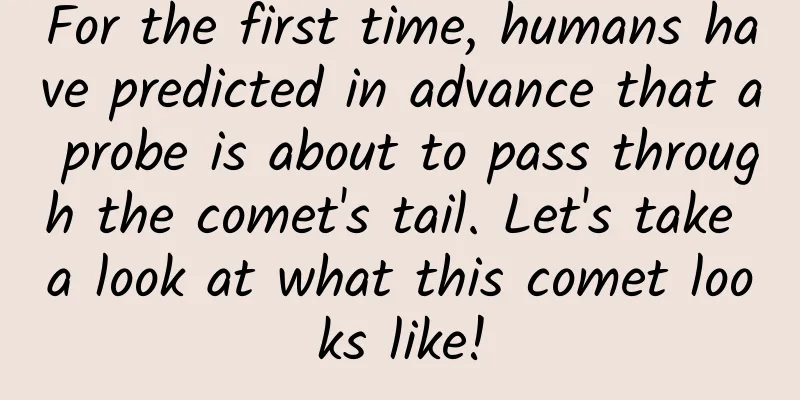For the first time, humans have predicted in advance that a probe is about to pass through the comet's tail. Let's take a look at what this comet looks like!

|
ESA's Solar Orbiter will pass through the tail of Comet ATLAS in the coming days, and while the newly launched spacecraft will not collect scientific data at this time, mission experts are already working to ensure that the four most relevant instruments are switched on during this unique encounter. The Solar Orbiter was launched on February 10, 2020, and since then scientists and engineers have been carrying out a series of tests and setup procedures. The completion date for this phase is set for June 15, so that the spacecraft can be fully functional for its first perihelion in mid-June. However, the discovery of the chance encounter with the comet has given matters a new urgency. An unexpected flyby through a comet's tail is a rare event for space missions, and scientists know of it happening only six times before, for missions that were not specifically chasing comets. All such encounters were discovered in spacecraft data after the event, while Solar Orbiter's upcoming crossover with the comet was the first one predicted in advance. It was noticed by Geraint Jones of the Murad Space Science Laboratory at University College London in the United Kingdom, who has a 20-year history of studying such encounters. He discovered the first unexpected comet tail crossing in 2000, while studying a strange disturbance in data recorded by the ESA/NASA Ulysses solar research spacecraft in 1996. The study showed the spacecraft crossing the tail of Comet Yakuta, also known as the "Great Comet of 1996." Soon after the announcement, Ulysses crossed the tail of another comet, and then a third in 2007. Earlier this month, realizing that Solar Orbiter would arrive 44 million kilometers downstream of Comet C/2019 Y4 (ATLAS) in just a few weeks, Geraint immediately notified the ESA team. Perfect detection instrument Solar Orbiter is equipped with a suite of 10 in situ and remote sensing instruments to study the Sun and the stream of charged particles it releases into space. Fortunately, the four in situ instruments are also perfect instruments to probe comet tails, because they measure the conditions around the spacecraft, so they can return data on the dust grains and charged particles emitted by the comet. These emissions form the comet's two tails: a dust tail that stays in the comet's orbit, and an ion tail that points directly toward the Sun. Solar Orbiter will pass through Comet ATLAS's ion tail between May 31 and June 1, and through the dust tail on June 6. If the ion tail is dense enough, Solar Orbiter's magnetometer (MAG) can detect changes in the interplanetary magnetic field as it interacts with ions in the comet's tail, while the Solar Wind Analyser (SWA) can capture some of the tail particles directly. As Solar Orbiter passes through a dust tail, depending on its density (which is extremely difficult to predict) there is a chance that one or more tiny dust grains will hit the spacecraft at tens of kilometers per second. While this poses no major risk to the spacecraft, the dust grains themselves can vaporize on impact, forming tiny clouds of electrically charged gas or plasma that can be detected by the Radio and Plasma Waves (RPW) instrument. "Unexpected encounters like this present unique opportunities and challenges for the mission, but that's good! Opportunities like this are all part of the scientific adventure," said Günther Hasinger, ESA's Director of Science. One of the challenges was that it seemed unlikely that the instruments would all be ready in time due to commissioning. Now, thanks to the extraordinary efforts of the instrument teams and ESA's mission operations team, all four on-site instruments will be switched on and collecting data, although at certain times the instruments will need to be switched back into commissioning mode to ensure the mission meets the 15 June deadline. Expect the unexpected Another challenge is the behavior of comets. Comet ATLAS was discovered on December 28, 2019. Over the following months, it grew so bright that astronomers wondered if it would become visible to the naked eye in May. Unfortunately, in early April, the comet fragmented. As a result, its brightness also decreased significantly, and further fragmentation in mid-May further weakened the comet, making it unlikely to be detected by Solar Orbiter. Even though the chances of detection have decreased, the effort is still worth it. With each encounter with a comet, researchers learn more about these intriguing objects. If Solar Orbiter detects the presence of Comet ATLAS, more will be learned about how comets interact with the solar wind, for example whether expectations about the behavior of dust tails agree with research models, and all comet encounter missions provide pieces of the puzzle. Geraint is the principal investigator of ESA's future Comet Interceptor mission, a three-spacecraft mission scheduled to launch in 2028. It will make a closer flyby of an unknown comet that will be picked out from the newly discovered comets, closer to launch (or even later). Close to the Sun Solar Orbiter is currently orbiting the Sun between the orbits of Venus and Mercury, with its first perihelion occurring on June 15, at a distance of about 77 million km. In the following years, it will get even closer, within the orbit of Mercury, to about 42 million km from the solar surface. Meanwhile, Comet ATLAS is already there, approaching its own perihelion, expected on May 31, at a distance of about 37 million km. Yannis Zouganelis, ESA's Deputy Project Scientist for Solar Orbiter, said: This comet tail crossing is also exciting because it will be the first time it will occur so close to the Sun, as the comet nucleus is within the orbit of Mercury. Understanding the dust environment of the innermost Solar System is one of Solar Orbiter's science goals. Close comets like Comet ATLAS are sources of inner heliospheric dust, so this study will not only help us understand this comet, but also the dust environments of stars. For Solar Orbiter, observing an icy comet instead of the hot Sun is certainly an exciting and unexpected way to begin the science mission. Bo Ke Yuan | Research/From: European Space Agency ESA Research published in the journal Research Notes of the AAS DOI: 10.3847/2515-5172/ab8fa6 |
>>: Petrochemicals, plastics and fossil fuels: Do you know how these industries are connected?
Recommend
Wearing AR glasses to assemble the Chinese space station, super cool
Not long ago, several students from Tsinghua Univ...
China's sea! The sea breeze brings the "taste" of 5G!
During this year's National Day holiday, Hong...
What will humans wear when they arrive on Mars?
For a long time, humans have been full of curiosi...
The most complete! New product launch event process planning plan!
The most important thing about an event is to hav...
New method of controlled nuclear fusion subverts expectations, is the first light about to be lit?
Yesterday I saw a piece of news that overturned m...
How to operate Tmall [Billion Club] merchant page?
After graduation, the author was assigned to the ...
Apple's new patent reveals that the iPhone will integrate NFC and fingerprint sensor
[September 10 news] Currently, many Android devic...
Event Operations: How to design event backend strategies?
Previously we learned the 6 basic elements necess...
A comprehensive review of mainstream VR engines at home and abroad: Which VR engine is the best?
Since Facebook acquired Oculus for $2 billion in ...
Comment: The 5G era will change the competition landscape of the mobile phone market, and Apple may suffer
Market research company Canalys recently released...
90% of people don’t know how to do user research. Do you?
Do you really understand user research? Can you d...
It is the domestic brands that offer rewards and engage in black public relations. Why are joint venture brands always silent? Here is the reason!
The “anti-gang storm” in China’s auto industry do...
A must-have website for advertisers, operators, and marketers! (Super full version)
2019 has passed 1/4 … It's time to recharge F...
Latest Age Regulations for Construction Workers 2022: What is the age limit for migrant workers on construction sites?
In rural areas, many farmers are forced to work i...
In-depth analysis of information flow, splash screen, and incentive video advertising!
Mobile advertising comes in many forms. For mobil...









